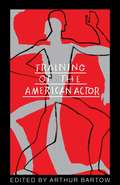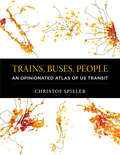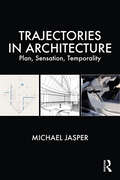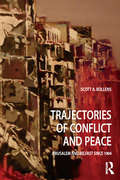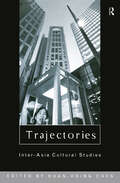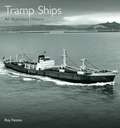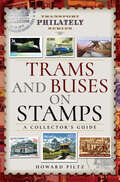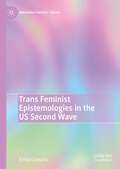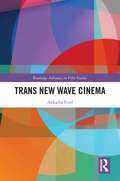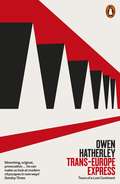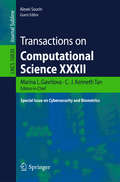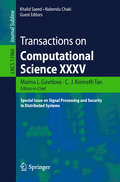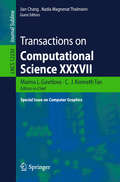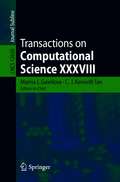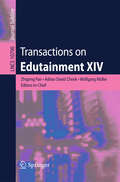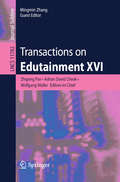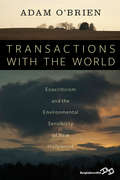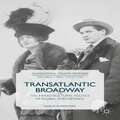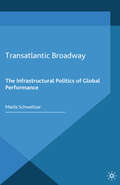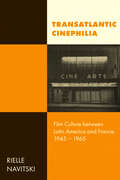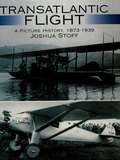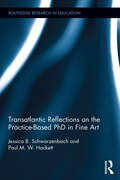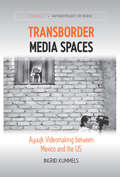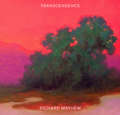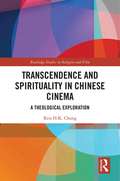- Table View
- List View
Training of the American Actor
by Arthur BartowSuccessful acting must reflect a society's current beliefs. The men and women who developed each new technique were convinced that previous methods were not equal to the full challenges of their time and place, and the techniques in this book have been adapted to current needs in order to continue to be successful methods for training actors. The actor's journey is an individual one, and the actor seeks a form, or a variety of forms, of training that will assist in unlocking his own creative gifts of expression.--from the introductionThe first comprehensive survey and study of the major techniques developed by and for the American actor over the past 60 years. Each of the 10 disciplines included is described in detail by one of today's foremost practitioners.Presented in this volume are:* Lee Strasberg's Method by Anna Strasberg, Lee's former student, widow, and current director of The Lee Strasberg Theatre Institute * Stella Adler Technique by Tom Oppenheim, Stella's grandson and artistic director of the Stella Adler Institute in New York * Sanford Meisner Technique by Victoria Hart, director of the Meisner Extension at New York University * Michael Chekhov Technique and The Mask by Per Brahe, a Danish teacher inspired by Balinese dance and introduced to the Chekhov technique in Russia * Uta Hagen Technique by Carol Rosenfeld, who taught under Hagen's tutelage at the Herbert Berghof (HB) Studio * Physical Acting Inspired by Grotowski by Stephen Wangh, who studied with Jerzy Grotowski himself * The Viewpoints by Mary Overlie, the creator of Viewpoints theory * Practical Aesthetics by Robert Bella of the David Mamet-inspired Atlantic Theatre Company school * Interdisciplinary Training by Fritz Ertl, who teaches at the Playwrights Horizons Theatre School * Neoclassical Training by Louis Scheeder, director of the Classical Studio of New York UniversityArthur Bartow is the artistic director of the Department of Drama at New York University's Tisch School of the Arts. A former associate director of Theatre Communications Group, he is the author of the landmark book The Director's Voice.
Trains, Buses, People: An Opinionated Atlas of US Transit
by Christof SpielerWhat are the best transit cities in the US? The best Bus Rapid Transit lines? The most useless rail transit lines? The missed opportunities?In the US, the 25 largest metropolitan areas and many smaller cities have fixed guideway transit—rail or bus rapid transit. Nearly all of them are talking about expanding. Yet discussions about transit are still remarkably unsophisticated. To build good transit, the discussion needs to focus on what matters—quality of service (not the technology that delivers it), all kinds of transit riders, the role of buildings, streets and sidewalks, and, above all, getting transit in the right places.Christof Spieler has spent over a decade advocating for transit as a writer, community leader, urban planner, transit board member, and enthusiast. He strongly believes that just about anyone—regardless of training or experience—can identify what makes good transit with the right information. In the fun and accessible Trains, Buses, People: An Opinionated Atlas of US Transit, Spieler shows how cities can build successful transit. He profiles the 47 metropolitan areas in the US that have rail transit or BRT, using data, photos, and maps for easy comparison. The best and worst systems are ranked and Spieler offers analysis of how geography, politics, and history complicate transit planning. He shows how the unique circumstances of every city have resulted in very different transit systems.Using appealing visuals, Trains, Buses, People is intended for non-experts—it will help any citizen, professional, or policymaker with a vested interest evaluate a transit proposal and understand what makes transit effective. While the book is built on data, it has a strong point of view. Spieler takes an honest look at what makes good and bad transit and is not afraid to look at what went wrong. He explains broad concepts, but recognizes all of the technical, geographical, and political difficulties of building transit in the real world. In the end,Trains, Buses, People shows that it is possible with the right tools to build good transit.
Trajectories in Architecture: Plan, Sensation, Temporality
by Michael JasperTrajectories in Architecture: Plan, Sensation, Temporality presents a compelling examination of underlying issues in late-twentieth-century architecture. Three formal preoccupations and conceptual orientations are used as guiding threads or trajectories. These three trajectories – the plan as conceptual device, a logic of sensation, and temporalities – serve to organise individual chapters in the central sections of the book and provide a new lens to the study of period work, revealing architectural conditions and consequent spatial effects little explored to date. Trajectories in Architecture adds to scholarship and expands our understanding of the role of conceptual and formal criteria in the analysis and creation of works of architecture. The book provides potentially transformative new interpretations of influential architects and key projects from the last half of the twentieth century to reveal new alignments and potentialities in architecture’s recent past as a contribution to identifying future possibilities. In so doing, the book argues for the still-latent potential in modern architecture’s traditions and design principles and their future expression. Trajectories in Architecture includes analysis of significant projects of Le Corbusier, Peter Eisenman, Zaha Hadid, John Hejduk, Louis I. Kahn, and I. M. Pei.
Trajectories of Conflict and Peace: Jerusalem and Belfast Since 1994 (Planning, History and Environment Series)
by Scott A BollensCreating peace for a city’s intimate enemies is harder than making war. This book is about the trajectories of urban conflict and peace in the politically polarized cities of Jerusalem and Belfast since 1994 – how sometimes there has been hopeful change while at other times debilitating stasis and regression. Based on extensive research, fieldwork, and interviews, Scott Bollens shows how seeking peace in these cities is shaped by the interaction of city-based actors and national elites, and that it is not just a political process, but a social and spatial one that takes place problematically over an extended period. He intertwines academic precision with ethnography and personal narrative to illuminate the complex political and emotional kaleidoscopes of these polarized cities. With hostility and competition among groups defined by ethnic, religious, and nationalistic identity on the increase across the world, this timely investigation contributes to our understanding of today’s fractured cities and nations.
Trajectories: Inter-Asia Cultural Studies (Culture and Communication in Asia)
by Kuan-Hsing ChenTrajectories brings together cultural theorists not only from countries with a known historical critical tradition such as America, Canada and Australia but from the East-Asia locations of Hong Kong, Korea, Singapore, Taiwan, Philippines, India and Thailand. It constitutes a critical confrontation between the imperial and colonial co-ordinates of north and south, east and west. Without rejecting the Anglo-American practices of cultural studies, the contributors present critical cultural studies as an internationalist and decolonized project. Trajectories links critical energies together and charts future directions of the discipline. The contributors discuss subjects such as Japanese colonial discourse, cultural studies out of Europe, Chinese nationalism in the context of global capitalism, white panic, stories from East Timor, queer life in Taiwan and new social movements in Korea. The book ends with an interview with Stuart Hall.
Tramp Ships: An Illustrated History
by Roy FentonWith 300 stunning photographs, this pictorial history of tramp trade ships illustrates the evolution of these charming, itinerant merchant vessels. The tramp ship was the taxi of the seas. With no regular schedules, it voyaged anywhere and everywhere, picking up and dropping off cargoes, mainly bulk cargoes such as coal, grain, timber, china clay and oil. Older and slower vessels tended to find their way into this trade, hence the tag 'tramp'—but new tramps were also built for the purpose. In this beautiful volume featuring 300 photographs, Roy Fenton illustrates the Tramp Ship&’s evolution over the course of more than 100 years, from the 1860s, when the steam tramp developed from the screw collier, until it was largely replaced by the specialist bulk carrier in the 1980s. Fenton offers fascinating background information on the design and building of tramps. He describes the machinery, from simple triple-expansion turbines to diesel engines. Their operation and management and the life of the officers and crews are also covered. This illustrated history journeys through the last years of the 19th century, the two world wars, and the postwar years. Photo captions provide each ship&’s dimensions, owners, and builder. Each ship&’s career is outlined with notes on trades and how they changed over a ship's lifetime.
Trams and Buses on Stamps: A Collector's Guide (Transport Philately Series)
by Howard PiltzIn this, the fourth edition of the Transport Philately series the author looks at the treatment of transport using roads rather than rail or air. There have been some particularly attractive and colorful issues of stamps over the years ranging from a trio of beautifully presented illustrations of Israel’s early buses to the well-known issue of double-deck buses produced by the Royal Mail in 2001, and who incidentally have seen the commercial opportunity by accompanying many issues with other paraphernalia, including a gentleman’s tie featuring many of the bus illustrations. A well-known colleague in the Public Transport world still wears his! Buses certainly are not as popular in the world of stamps as possibly aviation or wild-life, and trolleybuses even less so but the author has succeeded in finding a few, some of which are illustrated. Tramways, on the other hand, are a blessing to any collector with selections many and varied, some featuring trams from the beginning of the 20th century for their heritage interest to others providing an outlet of national or local pride at the inauguration of today’s systems in developed and developing countries across the world. Never a year goes by without a new issue appearing somewhere in the world and the author likes to keep an eye on several sources of information including regular publications from the renowned Stanley Gibbons organisation, the fount of all knowledge concerning philately, as well as other equally valuable contemporary publishers. Then there are regular stamp fairs held throughout the UK and the world where dealers compete for your business, and at some of the bigger occasions – the postal authorities themselves. On your computer are the various internet sites and auction platforms where there can often be some real surprises and bargains to be found.
Trans Feminist Epistemologies in the US Second Wave (Breaking Feminist Waves)
by Emily CousensWhy do “second wave” and “trans feminism” rarely get considered together? Challenging the idea that trans feminism is antagonistic to, or arrived after, second wave feminism, Emily Cousens re-orients trans epistemologies as crucial sites of second wave feminist theorising. By revisiting the contributions of trans individuals writing in underground print publications, as well as the more well-known arguments of Andrea Dworkin, this book demonstrates that valuable yet overlooked trans feminist philosophies of sex and gender were present throughout the US second wave. It argues that not only were these trans feminist epistemologies an important component of second wave feminism's knowledge production, but that this period has an unacknowledged trans feminist legacy.
Trans New Wave Cinema (Routledge Advances in Film Studies)
by Akkadia FordThis book presents a critical cultural study of the Trans New Wave as a cinematic genre and explores its emergence in the twenty-first century. Drawing on a diverse range of texts, the cultural, social, aesthetic and ethical implications of the genre are placed within the context of rapidly changing understandings of gender diversity. From the cinematic borderlands of independent film festivals to wider public recognition via digital technologies, the genre encompasses a diverse range of texts from short films, documentaries, experimental films, to feature films and narratives that range across life histories, narratives and themes. The book presents transliteracy as an original theoretical approach to reading film representations of the Trans New Wave, and combines it with a new theoretical concept of cinematic ethnogenesis to investigate how the genre emerged from specific communities and the reciprocal interaction of audiences and texts. This interdisciplinary volume engages with contemporary issues of gender diversity, transgender studies, screen and media studies and film festival studies, and as such will be of great interest to scholars working in these fields and in media and cultural studies more generally.
Trans-Europe Express: Tours of a Lost Continent
by Owen Hatherley'A scathing, lively and timely look at the "European city", from one of our most provocative voices on culture and architecture today' Owen JonesA searching, timely account of the condition of contemporary Europe, told through the landscapes of its citiesOver the past twenty years European cities have become the envy of the world: a Kraftwerk Utopia of historic centres, supermodernist concert halls, imaginative public spaces and futuristic egalitarian housing estates which, interconnected by high-speed trains traversing open borders, have a combination of order and pleasure which is exceptionally unusual elsewhere.In Trans-Europe Express, Owen Hatherley sets out to explore the European city across the entire continent, to see what exactly makes it so different to the Anglo-Saxon norm - the unplanned, car-centred, developer-oriented spaces common to the US, Ireland, UK and Australia. Attempting to define the European city, Hatherley finds a continent divided both within the EU and outside it. 'The latest heir to Ruskin.' - Boyd Tonkin, Independent 'Hatherley is the most informed, opinionated and acerbic guide you could wish for.' - Hugh Pearman, Sunday Times 'Can one talk yet of vintage Hatherley? Yes, one can. Here are all the properties that have made him one of the most distinctive writers in England - not just 'architectural writers', but writers full stop: acuity, contrariness, observational rigour, frankness and beautifully wrought prose.' - Jonathan Meades
Transactions on Computational Science XXXII: Special Issue On Cybersecurity And Biometrics (Lecture Notes in Computer Science #10830)
by Marina L. Gavrilova C.J. Kenneth Tan Alexei SourinThis, the 32nd issue of the Transactions on Computational Science, focusses on cybersecurity and biometrics. The eight detailed papers cover the following topics: Multimodal Warnings for Distracted Smartphone Users on the Move; EEG-Based Mental Workload and Stress Monitoring of Crew Members in a Maritime Virtual Simulator; Detecting Web Defacement and Enabling Web-Content Regeneration; Software as a Weapon in the Context of (Inter)national Security; Multi-user Architecture and Multi-player Games; An Adaptive Discrete Wavelet Transform Based Face Recognition Approach; Synthesizing Images of Imagined Faces Based on Relevance Feedback; and Neurofeedback Training to Enhance the Focused Attention of Elite Rifle Shooters.
Transactions on Computational Science XXXV: Special Issue on Signal Processing and Security in Distributed Systems (Lecture Notes in Computer Science #11960)
by Khalid Saeed Nabendu Chaki Marina L. Gavrilova C. J. Kenneth TanThe LNCS journal Transactions on Computational Science reflects recent developments in the field of Computational Science, conceiving the field not as a mere ancillary science but rather as an innovative approach supporting many other scientific disciplines. The journal focuses on original high-quality research in the realm of computational science in parallel and distributed environments, encompassing the facilitating theoretical foundations and the applications of large-scale computations and massive data processing. It addresses researchers and practitioners in areas ranging from aerospace to biochemistry, from electronics to geosciences, from mathematics to software architecture, presenting verifiable computational methods, findings, and solutions, and enabling industrial users to apply techniques of leading-edge, large-scale, high performance computational methods. This, the 35th issue of the Transactions on Computational Science, focusses on signal processing and security in distributed systems. The topics covered include classification of visual attention levels using microsaccades; analysis of textual content using Eyegaze; automatic car-accident detection and passenger counting; face recognition; secure data fusion in IoT; business compliance using goal models; and microfluidic executions.
Transactions on Computational Science XXXVII: Special Issue on Computer Graphics (Lecture Notes in Computer Science #12230)
by Marina L. Gavrilova C. J. Kenneth Tan Nadia Magnenat Thalmann Jian ChangThe LNCS journal Transactions on Computational Science reflects recent developments in the field of Computational Science, conceiving the field not as a mere ancillary science but rather as an innovative approach supporting many other scientific disciplines. The journal focuses on original high-quality research in the realm of computational science in parallel and distributed environments, encompassing the facilitating theoretical foundations and the applications of large-scale computations and massive data processing. It addresses researchers and practitioners in areas ranging from aerospace to biochemistry, from electronics to geosciences, from mathematics to software architecture, presenting verifiable computational methods, findings, and solutions, and enabling industrial users to apply techniques of leading-edge, large-scale, high performance computational methods.This, the 37th issue of the Transactions on Computational Science, is devoted to the area of Computer Graphics. The 9 papers included in the volume constitute extended versions of selected papers presented at the 36th Computer Graphics International Conference, CGI 2019. Topics covered include virtual reality, augmented reality, image retrieval, animation of elastoplastic material, and visualization of 360°HDR images.
Transactions on Computational Science XXXVIII (Lecture Notes in Computer Science #12620)
by Marina L. Gavrilova C. J. Kenneth TanThe LNCS journal Transactions on Computational Science reflects recent developments in the field of Computational Science, conceiving the field not as a mere ancillary science but rather as an innovative approach supporting many other scientific disciplines. The journal focuses on original high-quality research in the realm of computational science in parallel and distributed environments, encompassing the facilitating theoretical foundations and the applications of large-scale computations and massive data processing. It addresses researchers and practitioners in areas ranging from aerospace to biochemistry, from electronics to geosciences, from mathematics to software architecture, presenting verifiable computational methods, findings, and solutions, and enabling industrial users to apply techniques of leading-edge, large-scale, high performance computational methods.This, the 38th issue of the Transactions on Computational Science, is devoted to research on modelling, optimization, and graphs, with applications in 3D and sketch modelling, engineering design, evolutionary computing, and networks.
Transactions on Edutainment XIV (Lecture Notes in Computer Science #10790)
by Zhigeng Pan Adrian David Cheok Wolfgang MüllerThis journal subline serves as a forum for stimulating and disseminating innovative research ideas, theories, emerging technologies, empirical investigations, state-of-the-art methods, and tools in all different genres of edutainment, such as game-based learning and serious games, interactive storytelling, virtual learning environments, VR-based education, and related fields. It covers aspects from educational and game theories, human-computer interaction, computer graphics, artificial intelligence, and systems design. The 19 papers presented in the 14th issue were organized in topical sections named: 3D modeling and visualization; image; e-learning and games; and miscellaneous.
Transactions on Edutainment XVI (Lecture Notes in Computer Science #11782)
by Zhigeng Pan Adrian David Cheok Mingmin Zhang Wolfgang MüllerThis journal subline serves as a forum for stimulating and disseminating innovative research ideas, theories, emerging technologies, empirical investigations, state-of-the-art methods, and tools in all different genres of edutainment, such as game-based learning and serious games, interactive storytelling, virtual learning environments, VR-based education, and related fields. It covers aspects from educational and game theories, human-computer interaction, computer graphics, artificial intelligence, and systems design. The 27 papers presented in this issue were organized in topical sections named: e-learning and on-line apps; image and graphics; VR/AR; CV and AI; and animation and miscellaneous.
Transactions with the World: Ecocriticism and the Environmental Sensibility of New Hollywood
by Adam O'BrienIn their bold experimentation and bracing engagement with culture and politics, the "New Hollywood" films of the late 1960s and early 1970s are justly celebrated contributions to American cinematic history. Relatively unexplored, however, has been the profound environmental sensibility that characterized movies such as The Wild Bunch, Chinatown, and Nashville. This brisk and engaging study explores how many hallmarks of New Hollywood filmmaking, such as the increased reliance on location shooting and the rejection of American self-mythologizing, made the era such a vividly "grounded" cinematic moment. Synthesizing a range of narrative, aesthetic, and ecocritical theories, it offers a genuinely fresh perspective on one of the most studied periods in film history.
Transatlantic Broadway
by Marlis SchweitzerTransatlantic Broadway traces the infrastructural networks and technological advances that supported the globalization of popular entertainment in the pre-World War I period, with a specific focus on the production and performance of Broadway as physical space, dream factory, and glorious machine. Inspired by post-humanist scholarship, this book pays heed to the non-human entities and the backgrounded or disappeared human laborers who participated in the transnational expansion of theatre networks. In particular, it examines the transnational performances of ocean liners, piers, telegraph cables, telegrams, typewriters, office spaces, newspapers, and postcards and asks how these objects, as participants in a series of complicated networks, transformed the machinery of US theatre as well as the everyday practices of those who produced and consumed it. In so doing, it identifies surprising connections between the most mundane of actions - typing a letter, turning over a postcard - and the most extraordinary - firing a torpedo, declaring war.
Transatlantic Broadway: The Infrastructural Politics of Global Performance (Transnational Theatre Histories)
by M. SchweitzerTransatlantic Broadway traces the infrastructural networks and technological advances that supported the globalization of popular entertainment in the pre-World War I period, with a specific focus on the production and performance of Broadway as physical space, dream factory, and glorious machine.
Transatlantic Cinephilia: Film Culture between Latin America and France, 1945–1965 (Cinema Cultures in Contact #6)
by Rielle NavitskiIn the two decades after World War II, a vibrant cultural infrastructure of cineclubs, archives, festivals, and film schools took shape in Latin America through the labor of film enthusiasts who often worked in concert with French and France-based organizations. In promoting the emerging concept and practice of art cinema, these film-related institutions advanced geopolitical and class interests simultaneously in a polarized Cold War climate. Seeking to sharpen viewers' critical faculties as a safeguard against ideological extremes, institutions of film culture lent prestige to Latin America's growing middle classes and capitalized on official and unofficial efforts to boost the circulation of French cinema, enhancing the nation's soft power in the wake of military defeat and occupation. As the first book-length, transnational analysis of postwar Latin American film culture, Transatlantic Cinephilia deepens our understanding of how institutional networks have nurtured alternative and nontheatrical cinemas.
Transatlantic Flight: A Picture History, 1873–1939
by Joshua StoffProfusely illustrated volume chronicles exciting saga of international race to make transatlantic flight a reality. Over 250 rare photographs -- many previously unpublished -- trace a host of flight attempts, including those made in lighter-than-air balloons, U.S. Navy's "flying boats," Lindbergh's flight to Paris in 1927, Earhart's ill-fated attempt in 1937, and more.
Transatlantic Reflections on the Practice-Based PhD in Fine Art (Routledge Research in Education)
by Paul Hackett Jessica SchwarzenbachOnce the US was the only country in the world to offer a doctorate for studio artists, however the PhD in fine art disappeared after pressures established the MFA as the terminal degree for visual artists. Subsequently, the PhD in fine art emerged in the UK and is now offered by approximately 40 universities. Today the doctorate is offered in most English-speaking nations, much of the EU, and countries such as China and Brazil. Using historical, political, and social frameworks, this book investigates the evolution of the fine art doctorate in the UK, what the concept of a PhD means to practicing artists from the US, and why this degree disappeared in the US when it is so vigorously embraced in the UK and other countries. Data collected through in-depth interviews examine the perspectives of professional artists in the US who teach graduate level fine art. These interviews disclose conflicting attitudes toward this advanced degree and reveal the possibilities and challenges of developing a potential doctorate in studio art in the US.
Transborder Media Spaces: Ayuujk Videomaking between Mexico and the US (Anthropology of Media #7)
by Ingrid KummelsTransborder Media Spaces offers a new perspective on how media forms like photography, video, radio, television, and the Internet have been appropriated by Mexican indigenous people in the light of transnational migration and ethnopolitical movements. In producing and consuming self-determined media genres, actors in Tamazulapam Mixe and its diaspora community in Los Angeles open up media spaces and seek to forge more equal relations both within Mexico and beyond its borders. It is within these spaces that Ayuujk people carve out their own, at times conflicting, visions of development, modernity, gender, and what it means to be indigenous in the twenty-first century.
Transcendence
by Richard MayhewTranscendence is the long-awaited, career-spanning monograph of American landscape painter Richard Mayhew. For over half a century, Richard Mayhew has been reinventing the genre of landscape painting. His luminous work evokes not only physical vistas but also emotions, sounds, and the pure experience of color.He's known for his masterful use of color and for his unique creative process, inspired by improvisational jazz, which involves pouring paint directly onto the canvas and shaping it into lush, emotional "moodscapes."• This monograph features 70+ of his most striking works.• Includes an exclusive interview with the artist, an introduction by his gallerist Mikaela Sardo Lamarche, and an essay by Andrew Walker, director of the Amon Carter Museum of American Art• Through engaging with his work, readers are invited into deep explorations of their own inner landscapes.Transcendence is a richly rewarding celebration of an iconic artist that will make you rethink everything you know about landscape painting.Mayhew's distinctive style emerges from his roots as a jazz musician, his immersion in the Abstract Expressionist movement, his African American, Cherokee, and Shinnecock heritage, and his unique affinity for the landscapes of the American West—but his paintings transcend boundaries of location and identity.• Great for lovers of fine art, landscape painting, Abstract Expressionism, as well as those who are interested in the intersection of art, music, and emotion• A lush celebration of Richard Mayhew's work, and an ideal introductory book for new fans• Add it to the collection of books like Abstract Expressionism by Carter Ratcliff, Jeremy Lewison, Susan Davidson, and David Anfam; California Landscapes: Richard Diebenkorn / Wayne Thiebaud by John Yau; and The Art of Richard Mayhew: A Critical Analysis with Interviews by Janet Berry Hess.
Transcendence and Spirituality in Chinese Cinema: A Theological Exploration (Routledge Studies in Religion and Film)
by Kris H.K ChongThis book provides a framework by which a global audience might think theologically about contemporary films produced in mainland China by Chinese directors. Up to this point the academic discipline of Christian theology and film has focussed predominantly on Western cinema, and as a result, has missed out the potential insights offered by Chinese spirituality on film. Mainland Chinese films, produced within the nation’s social structure, offer an excellent lingua franca of China. Illuminating the spiritual imagination of Chinese filmmakers and their yearning for transcendence, the book uses Richard A. Blake’s concept of afterimage to analyse the potential theological implications of their films. It then brings Jürgen Moltmann’s "immanent-transcendence" and Robert K. Johnston’s "God’s wider Presence" into conversation with Confucianist and Daoist ideas of there being, spirituality-speaking, "More in Life than Meets the Eye" than simply material existence. This all combines to move beyond film and allow for a Western audience to gain a new perspective on Chinese culture and traditions. One that uses familiar Western terms, while avoiding the imposition of a Western mindset. This is a new perspective on cinema, religion and Chinese culture that will be of keen interest to scholars of Religion and Film, Religious Studies, Theology, Sociology of Religion and Chinese Studies.
